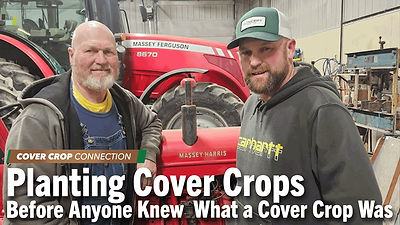We all hear the benefits touted about cover crops- less erosion, having a living plant in the ground at all times, alleviating compaction, retaining nutrients for the next crop, giving food and shelter to microbes in the soil, and so on. It is a great list and will do some miraculous things to the soil. Try it on a limited basis, if you haven’t already. Then get a shovel out and really look at what happened. There are some benefits that definitely go with cover crops. However, there are some things you should know beforehand that really can affect how those cover crops grow. We have two years under our belt now with our highboy planter. It has been a couple really wet years, so they haven’t been the best, but we have learned some interesting things that I think need to be shared. They are things that I have NOT heard in any other cover crop presentation. It’s like, “plant them and life will be good”. Well, not here. We have really struggled to get some good crops growing, but with the lessons learned, I think that will change.
First, plant as early as you can. If you get past September 15th or so, you better be using the right varieties. Most will not get established enough to survive the winter. Most presentations will tell you this.
Second (and here are the things you may not get in other presentations), cover crops that we have planted do not like “wet feet”. That is, they do not like growing in wet conditions. This year is different, but what have the last 3 years been? WET! And, if you have a particularly wet area in those fields, cover crops will not grow at all. Some of this is just the soils we are blessed with.
Third, I believe we are seeing benefits of very slight surface disturbance. Disturbing the ground just a little bit helps the crops start growing a lot better. I love no-till planting, but this appears to be working even a little better than that (maybe??). You can just do a light disking, or some vertical tillage if you have that equipment. You don’t need to go deep — simply break up the top inch of ground. It seems to really make a difference, especially if broadcasting the seed. We need a few more years to watch this one.
Lastly, and most importantly, it needs nutrients. A number of organizations out there praise cover crops for producing and sequestering nutrients for the next crop. Some even drill deep into the soil and bring these nutrients to the top of the ground. All that is good, if the cover crop is actually growing. The problem in this area is that we have done such a good job of not over-applying nutrients, that there isn’t anything left for the cover crop. We give the cash crop just what it needs. That is what we have been told to do for a long time. Having done that, we have nothing left to grow the cover crop, and therefore, disappointment. However, adding more nutrients is expensive and the wrong way from where we are supposed to be going, right? It is a catch 22. Over-applying nutrients is a bad thing, but if there are no extra, we don’t have a good cover crop. And if we fertilize it, then we are adding more nutrients.



